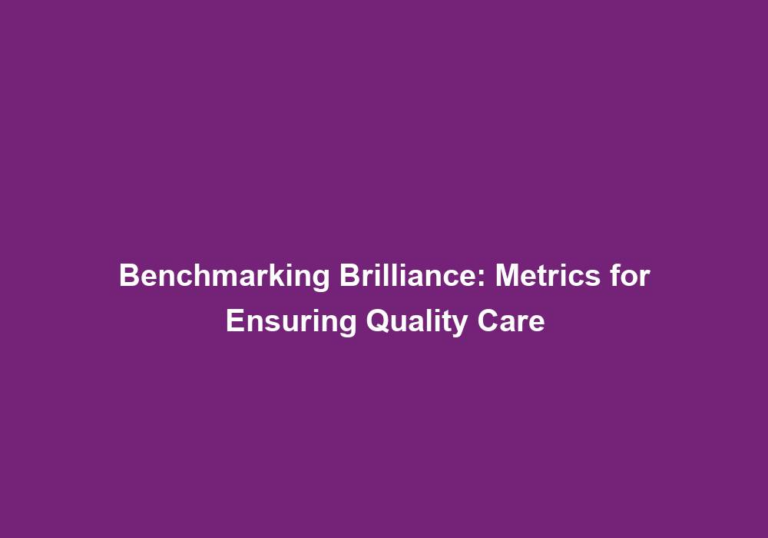Decoding Care Quality: Metrics and Measurements for Excellence
In an ever-evolving healthcare landscape, ensuring the delivery of high-quality care is vital for healthcare providers and organizations. However, measuring and evaluating care quality can be a daunting task. This article aims to decode the metrics and measurements used to assess care quality, providing valuable insights for healthcare professionals striving for excellence in their practices.
The Importance of Care Quality Metrics
Measuring care quality is essential to identify areas of improvement, optimize patient outcomes, and enhance overall healthcare delivery. Reliable care quality metrics enable healthcare providers to track performance, benchmark against industry standards, and identify potential gaps in care. By utilizing these metrics, healthcare organizations can focus on delivering patient-centered, evidence-based care, ultimately leading to better patient satisfaction and outcomes.
1. Patient Satisfaction Surveys
Patient satisfaction surveys are crucial for gaining insights into how patients perceive the care they receive. These surveys typically assess various aspects of the patient experience, including communication with healthcare providers, wait times, overall facility cleanliness, and the overall patient-doctor relationship. Analyzing survey results can highlight areas of improvement and help tailor care delivery to meet patient expectations.
- Prompt communication with healthcare providers: Patients value clear and timely communication from their healthcare providers. By ensuring that patients have access to necessary information and addressing their concerns promptly, healthcare organizations can improve patient satisfaction.
- Efficient management of wait times: Long wait times can lead to frustration and dissatisfaction. Implementing strategies to reduce wait times, such as optimizing scheduling processes and improving workflow efficiency, can enhance the patient experience.
- Maintaining clean and welcoming facilities: A clean and well-maintained environment contributes to a positive patient experience. Regular cleaning schedules, infection prevention protocols, and comfortable waiting areas can all contribute to patient satisfaction.
- Nurturing patient-doctor relationships: Building strong patient-doctor relationships based on trust and effective communication is crucial for delivering quality care. Providers who actively engage with patients, listen attentively, and involve them in decision-making processes can enhance patient satisfaction and overall care quality.
2. Clinical Outcome Measures
Clinical outcome measures evaluate the effectiveness of healthcare interventions or treatments. These measures often include outcome indicators such as mortality rates, complication rates, readmission rates, and length of hospital stay. By tracking these metrics, healthcare providers can assess the impact of their interventions and identify opportunities for improvement.
- Monitoring mortality rates: Low mortality rates indicate successful treatment outcomes and effective care delivery. Healthcare organizations should aim to maintain low mortality rates by implementing evidence-based practices, ensuring proper patient monitoring, and promptly addressing any complications.
- Reducing complication rates: Complications during and after treatments can significantly impact patient outcomes. Healthcare providers should focus on identifying and addressing factors that contribute to complications, such as infection prevention protocols, surgical techniques, and medication management.
- Managing readmission rates: High readmission rates may signal gaps in care coordination or inadequate post-discharge follow-up. Healthcare organizations should implement strategies to improve care transitions, provide effective discharge instructions, and ensure appropriate post-discharge support to minimize readmissions.
- Optimizing length of hospital stay: Lengthy hospital stays can increase the risk of infections and other complications. By streamlining care processes, improving care coordination, and implementing evidence-based practices, healthcare providers can reduce the length of hospital stays, leading to better patient outcomes.
3. Adherence to Evidence-Based Guidelines
Evidence-based guidelines provide healthcare professionals with a framework for delivering care based on the best available evidence. Assessing adherence to these guidelines helps evaluate the quality of care provided. Metrics such as adherence rates to recommended treatments, medication protocols, and preventive screenings can provide insights into the effectiveness and consistency of care.
- Ensuring adherence to recommended treatments: Following evidence-based treatment guidelines improves patient outcomes and reduces variations in care. Healthcare providers should regularly assess their adherence to treatment protocols and identify areas for improvement to ensure consistent and high-quality care delivery.
- Monitoring medication protocols: Medication errors can have serious consequences for patient safety. By implementing medication reconciliation processes, standardized medication protocols, and regular medication reviews, healthcare organizations can minimize medication errors and enhance patient outcomes.
- Performing preventive screenings: Preventive screenings play a crucial role in early detection and prevention of diseases. Tracking adherence to recommended screenings, such as mammograms, colonoscopies, and vaccinations, helps identify opportunities to improve preventive care and reduce the burden of chronic illnesses.
4. Care Coordination and Continuity
Care coordination and continuity are vital aspects of high-quality care. Metrics related to care coordination include the number of care transitions, effective communication among healthcare providers, and the timely exchange of information between different care settings. Evaluating these metrics can identify potential gaps in care coordination and help streamline care delivery processes.
- Reducing care transitions: Excessive care transitions can lead to fragmented care and increased risk of medical errors. Healthcare organizations should aim to minimize unnecessary transfers and ensure smooth transitions between care settings to promote continuity of care.
- Improving interprofessional communication: Effective communication among healthcare providers is essential for coordinated care delivery. Implementing standardized communication protocols, utilizing electronic health records for information exchange, and fostering collaborative relationships between different healthcare teams can enhance care coordination and patient outcomes.
- Timely exchange of information: Timely and accurate exchange of patient information is crucial for providing optimal care. Healthcare organizations should establish secure systems for sharing patient data across different care settings, enabling healthcare providers to access relevant information promptly and make well-informed decisions.
5. Patient Safety Indicators
Patient safety indicators assess the occurrence of adverse events, medical errors, and other preventable complications during healthcare encounters. These metrics measure aspects such as hospital-acquired infections, medication errors, falls, and pressure ulcers. Monitoring patient safety indicators facilitates the identification of areas where improvements are needed to enhance patient safety and reduce harm.
- Preventing hospital-acquired infections: Healthcare-associated infections pose a significant threat to patient safety. Implementing strict infection prevention protocols, promoting hand hygiene practices, and regularly monitoring infection rates can mitigate the risk of hospital-acquired infections.
- Minimizing medication errors: Medication errors can lead to serious harm or even death. Healthcare organizations should implement medication safety strategies, such as barcode scanning systems, medication reconciliation processes, and robust medication education programs for healthcare professionals, to minimize the occurrence of medication errors.
- Preventing falls and pressure ulcers: Falls and pressure ulcers are common preventable complications in healthcare settings. Implementing fall prevention protocols, conducting risk assessments, and utilizing pressure-reducing devices can help mitigate these risks and improve patient safety.
Best Practices in Using Care Quality Metrics
To effectively leverage care quality metrics, healthcare organizations should consider the following best practices:
- Regular Data Collection: Routinely collect data on care quality metrics to establish benchmarks and track progress over time. Regular data collection enables healthcare organizations to identify trends, measure the impact of improvement initiatives, and make data-driven decisions.
- Data Transparency: Share care quality data with healthcare professionals, patients, and the public to promote accountability and foster trust. Transparency enhances collaboration, encourages continuous improvement, and empowers patients to make informed decisions about their healthcare.
- Benchmarking: Compare care quality metrics against national standards, industry benchmarks, and peer organizations to identify areas for improvement. Benchmarking provides valuable insights into best practices and allows organizations to learn from high-performing healthcare providers.
- Continuous Quality Improvement: Utilize care quality metrics as a feedback loop to drive continuous improvement initiatives and enhance patient outcomes. Regularly analyze data, identify areas for enhancement, implement evidence-based strategies, and monitor the impact on care quality.
- Multidisciplinary Collaboration: Engage healthcare professionals from various disciplines in the analysis and interpretation of care quality metrics to gain diverse perspectives and foster collaboration in performance improvement efforts. Multidisciplinary collaboration promotes a holistic approach to care delivery and ensures comprehensive evaluation of care quality.
By adopting these best practices, healthcare organizations can effectively use care quality metrics to drive excellence in care delivery.
Conclusion
Decoding care quality metrics and measurements is crucial for healthcare organizations striving for excellence in care delivery. By understanding and utilizing key metrics such as patient satisfaction surveys, clinical outcome measures, adherence to evidence-based guidelines, care coordination and continuity metrics, and patient safety indicators, healthcare providers can enhance patient outcomes, optimize care processes, and improve overall healthcare quality. Embracing best practices in using care quality metrics further enables organizations to continuously assess and improve their care delivery practices, ultimately leading to better patient experiences and outcomes.






